4 Steps to Avoid ‘Analysis Paralysis’ and Improve Customer Experience
“Look before you leap!” This nearly 500-year-old proverb is a common reminder to people facing tough decisions. But when there’s a lot at stake, people can get stuck.
The term analysis paralysis describes the condition of those who get so overwhelmed with the “looking” that they never make it to the “leaping”—and it happens to business decision-makers as well as everyday people.
Leaders facing decisions that affect multiple parts of their business are most at risk of analysis paralysis. In the early 2000s, many got stuck trying to decide how to make use of the growing number of analytical customer relationship management (CRM) tools.
Today, many business leaders find themselves paralyzed by the topics of customer experience (CX) and CX improvement.
The Four-Step Model to Improve Customer Experience
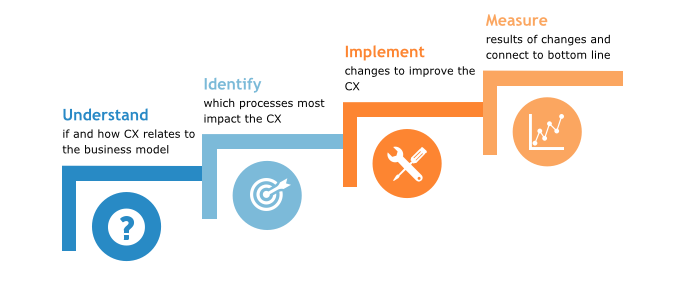
In this post, we’ll show you how the decision to “improve customer experience” can be broken down into a four-step series of smaller, simpler decisions.
This will help you quickly begin improving your company’s CX so you can start receiving the boost to competitiveness it brings—all with a much lower chance of getting stuck along the way.
 Step 1: Understand if CX Is Important to Your Business
Step 1: Understand if CX Is Important to Your Business
We start with the easiest question business leaders need to ask themselves: “Does CX even play a role in our company’s success?” This question is easy, because the answer is nearly always “yes.”
“62 percent of consumers have switched brands after having a poor customer experience.”
– Parature, 2013 Customer Service Expectations and Frustrations study
Consumers today care more about CX than ever before. In fact, in many cases, CX is the primary factor consumers consider when choosing a product or brand.
“86 percent of buyers will pay more for a better customer experience.”
– Oracle, RightNow, 2011 US Customer Experience Impact (CEI) report
Given the wide variety of business models operating across industries and offering different value propositions to customers, how can you be sure that CX is relevant to the success of your business? Try navigating through the question tree below. If the answer to any question is “yes,” you can be sure that CX does matter.
Does Customer Experience Matter to Your Business?
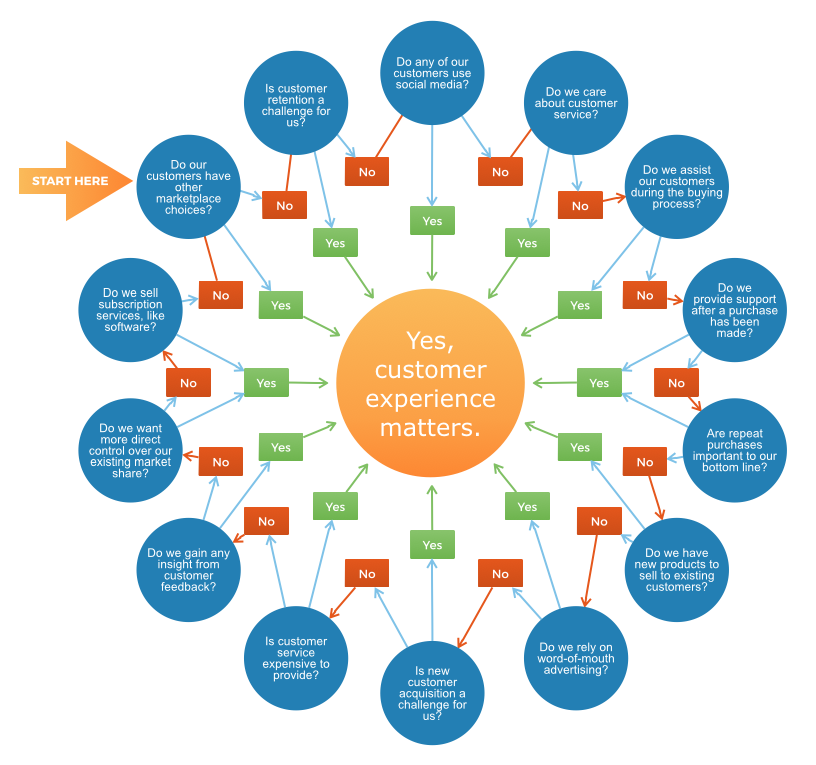
_Much like CX improvement, this chart might seem overwhelming at first,
but it’s actually quite simple_
 Step 2: Identify Which Processes Impact CX Most
Step 2: Identify Which Processes Impact CX Most
In this step, you’ll figure out which CX improvements are most important. The best way to start is by identifying your primary customer journey maps.
“A customer journey map is … a diagram that illustrates the steps your customer(s) go through in engaging with your company, whether it be a product, an online experience, retail experience or a service, or any combination.”
– Adam Richardson, Harvard Business Review
Here’s a customer journey map for an example software company, which offers its product through a free trial period. The map shows six milestones in a customer’s relationship with the company. Each of the milestones involves one or more interactions between the customer and the company’s website, product or personnel.
Each interaction is called a “touchpoint”—and all the touchpoints, taken together, create the customer experience.
Journey Map for Software Offered Through Trial Period
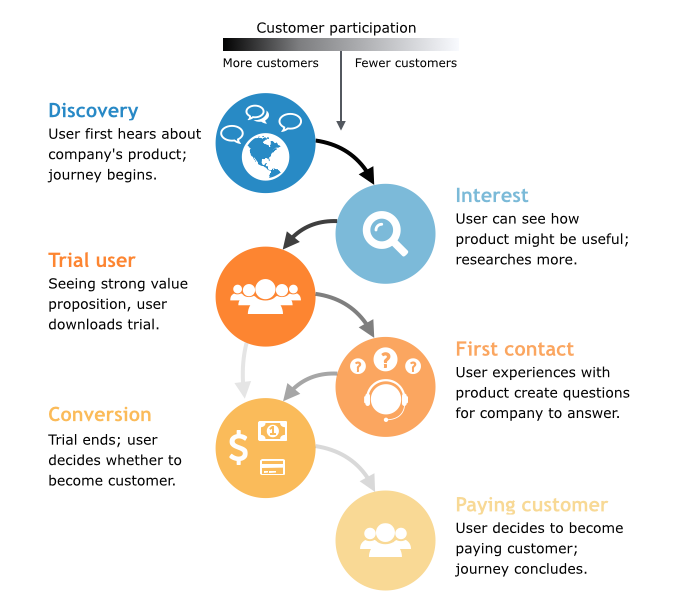
In order to improve customer experience, you must start by improving individual touchpoints. But not all touchpoints carry equal weight: Some, if handled poorly, are just a small bump in the customer’s journey, while others could mean the end of a relationship. Businesses must assess their customer journey maps to identify which touchpoints are causing problems, which can be easily improved and which need the most immediate attention.
Now, here’s the catch: Whether touchpoints are handled well or poorly is in the eyes of the customer. So, while companies might have an idea, it’s really the customers who know best which touchpoints should be addressed first.
Survey and opinion-gathering tools, such as Agiloft and Tracker, help companies gather feedback at specific touchpoints and across different journey maps. The information they gather can help you decide which touchpoints to improve first—and this can greatly impact your company’s CX improvement results.
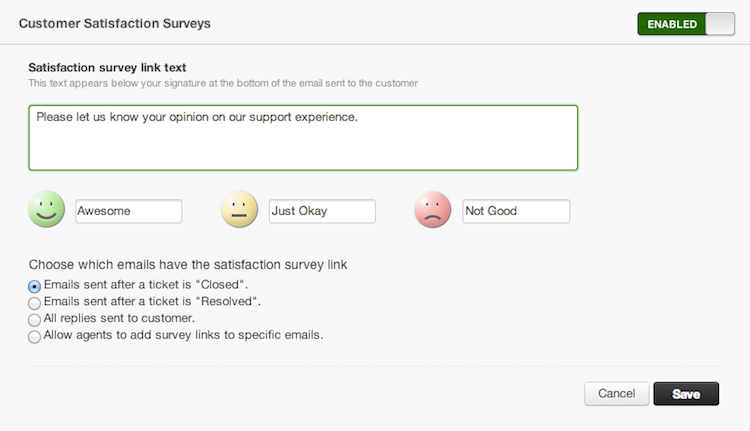

Company view of survey settings in the Freshdesk customer service platform, showing options to have a survey presented during specific touchpoints
 Step 3: Implement Process Changes to Improve CX
Step 3: Implement Process Changes to Improve CX
After identifying which touchpoints to address first, the next step is deciding which process changes and tools are best for improving them. Sometimes, a business can make small, easy changes that improve CX dramatically. Other times, dramatic changes lead to small results.
90 percent of consumers we surveyed say they regularly have a negative CX when using mobile devices to search for information about products and services. Yet the changes needed to provide better mobile CX are very easy to implement.
Going back to the example above, our software company learns from analyzing its customer journey map (as well as its trial and subscription rates) that only a small percentage of trial users become paying customers. Many are dropping off in the “first contact” stage of the journey.
The first contact stage has three possible touchpoints: Customers with questions can look in the company’s online FAQ for answers, they can call on the phone or they can use live chat through the website. To understand why so many trial users fail to become paying customers, the company deploys survey software to gather information.
Results from the survey show that many trial users had simple misunderstandings about the product—ones that could have been easily corrected if they’d read the FAQ, called the company or used live chat. Some respondents say they looked at the FAQ page, but didn’t see the answer to their question; others say the text in the chat window was too small to read on their mobile phone.
Armed with this, the software company invests in knowledge management (KM) software. This tracks the information resources customers and/or service agents use most frequently, and uses them to populate the online FAQ page—ensuring the most frequently asked questions are also the most frequently answered.
Finally, the company upgrades its live chat platform to one with mobile chat capabilities (e.g., Engage or Velaro) to keep customers from squinting into frustration.
 Step 4: Measure Results and Connect to Bottom Line
Step 4: Measure Results and Connect to Bottom Line
In our example above, the software company could very easily measure the results of better KM software or a mobile-compatible live chat platform: through both survey responses and by seeing if more trial users converted to paying customers.
In reality, most businesses have more intricate journey maps. And with more stages in the journey and touchpoints to consider, it becomes more challenging to measure results. This is further complicated by the fact that, in many cases, CX improvements require the cooperation of multiple departments.
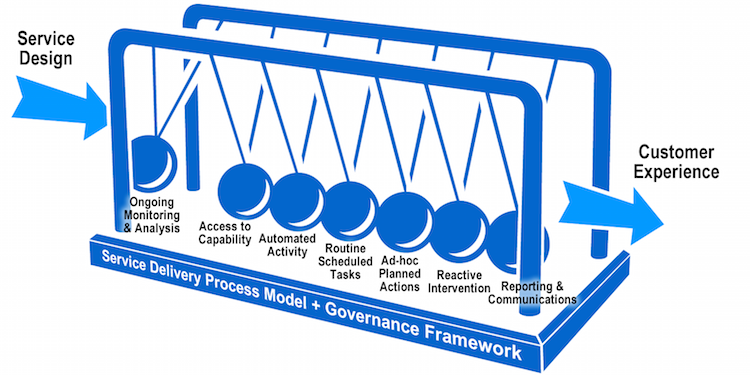
_Factors that create the CX for a Software-as-a-Service company
(Source: Gartner Blog Network)_
As business size grows and organizational structure becomes more complex, it becomes more challenging to implement direct improvements to CX—not only for the reasons above, but also for reasons of ownership.
For example, imagine a problematic touchpoint that can only be improved if the engineering team works with the customer service team to follow suggestions made by the marketing and sales teams. Which team will own the project and be responsible for its success or failure?
At this stage, many larger businesses meet analysis paralysis. (This is also the reason so many large organizations are moving beyond the traditional approach of departmentalization.)
Interestingly, businesses in these situations turn to many of the same tools as businesses in simpler situations, such as our example software company: Opinion-gathering and survey tools are used, though more complex customer journeys require more sophisticated software, such as the customer experience management platforms offered by Medallia and Satmetrix.
These platforms monitor and help improve customer experiences across multiple channels, touchpoints and journey maps to present a unified view of the CX status quo. Dedicated CX platforms also allow for more granular measurements, thanks to specialized applications, such as text- and voice-based sentiment analysis.
This type of analysis estimates whether the customer is (for example) happy, neutral or frustrated from their word choices or voice inflection, and provides clues to which touchpoints along the journey might need attention.
Ultimately, more than one road leads to business success. These days, most roads are built on giving customers better touchpoints and smoother journeys—and they’re built with the help of software. Consumers clearly favor companies that leap into action to provide better CX, and they reward them by becoming more interested, engaged and loyal customers.